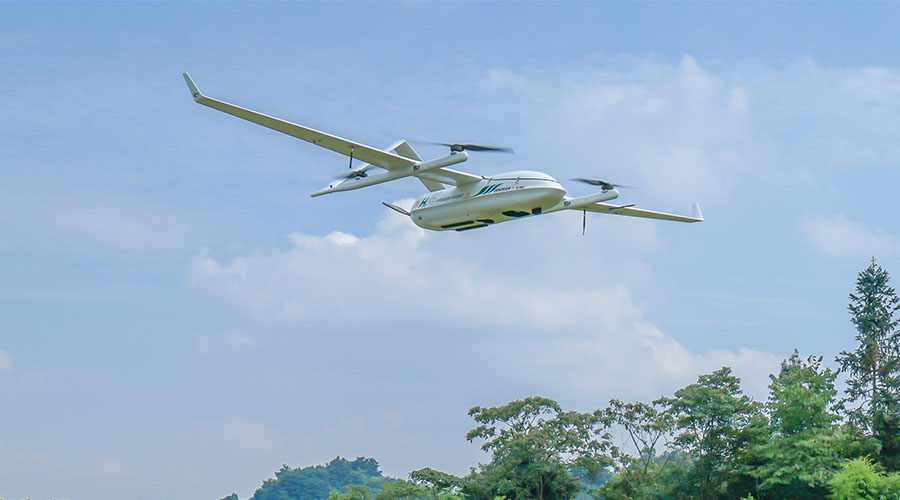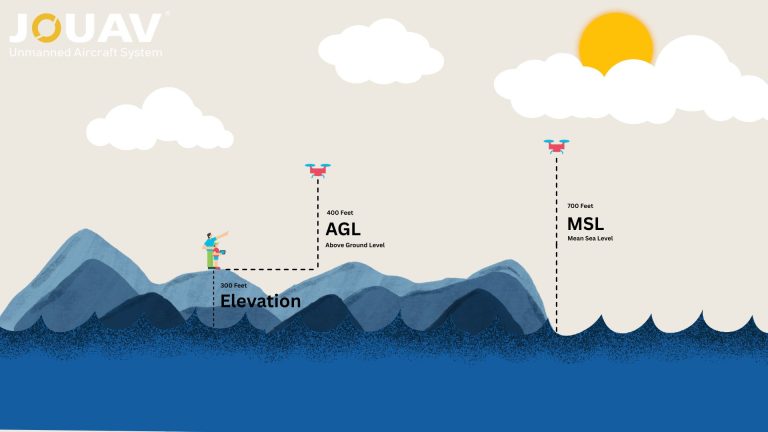Gas Powered Drone: A Quick Start Guide
As the world shifts toward electrification, the vast majority of commercial drones now use lithium-ion (Li-Po) battery-powered motors, but that doesn't mean there isn't a place for other powered drones. Gas powered drones, which can fly longer than battery-powered ones and don't require charging or recharging, are being used extensively for racing and recreational flying. And in the near future, they are expected to become a staple of professional photography and videography.
However, as with any not-so-common technology, people are skeptical about gas powered drones. Are you curious about how they work and what they're good for? That's exactly the question we'll be answering in this guide. Beyond that, we'll look at the top 3 gasoline powered drones currently on the market, based on consumer reviews.
Let’s get started.
What is a gas powered drone?
Gas powered drones, as the name indicates, are drones that can fly on regular gas or 2-cycle motor oil, rather than being powered by battery charging. Equipped with an internal combustion engine and a fuel tank, gas operated drones rely primarily on the combustion of gasoline in the engine to provide power.
With the abundance of drone applications, there is a higher demand for the flight time of drones. Fuel powered drones have a longer range and can carry heavier payloads than electric drones, filling a gap in the market.

How do gas powered drones work?
As we mentioned above, gas-powered UAVs use a spark-ignition internal combustion engine as the primary propulsion system. In a spark ignition system, fuel is mixed with air and then introduced into the cylinder during the air intake. After the piston compresses the fuel-air mixture, the spark ignites it, causing combustion, producing gas, and emitting a large amount of heat. The piston in turn rotates the crankshaft. Eventually, the aircraft is given a lift through a gear system in the powertrain.
Advantages of gas powered drones
Designed to overcome the disadvantages of electric counterparts, gas-powered drones have many advantages that make more drone applications possible. Let's take a look at their advantages:
- Can fly continuously for hours on a single tank of fuel, no need to land and constantly refuel the drone.
- The heavier structure allows the gas drones to remain stable in windy conditions.
- Gas powered drones can be equipped with heavier cameras or other sensors
- The heavier structure allows the gasoline drones to remain stable in windy conditions.
- Fly faster than most battery-powered multi-rotor drones due to its increased power output.
- Refueling takes only a few seconds, no need to wait hours to recharge the battery.
- Require less maintenance because of fewer components.
Disadvantages of gas powered drones
However, gas-powered drones are not perfect; they are complex, expensive, and more prone to failure than all-electric drones...
Read on to learn about the other disadvantages of using gas-powered drones.
- The large size makes them less portable and less maneuverable in tight spaces.
- More expensive than electric drones. According to market research, the average price of a gas powered quadcopter drone is about $30,000, about four times more expensive than an electric counterpart with the same capabilities.
- Generate a lot of noise pollution than a battery-powered drone.
- Most of the market is for DIY gas-powered drones. Off-the-shelf gas-powered drones (RTFs) are hard to come by, and that's why many people learn how to build a gas-powered drone.
- Potentially dangerous due to flying with highly flammable fuel tanks.
- More complex to use and requires more piloting skills than electric drones.
- Compared to electric drones, fuel-powered aircraft have relatively complex motors and require relatively high maintenance and repair.
Gas powered drone uses & applications
Compared to battery-powered aircraft, gas-powered drones are a niche product, but they are starting to gain importance due to their excellent flight efficiency and payload capacity. Nowadays, gas-powered drones are being used in different industries. Their main applications include the following:
Emergency response and rescue service
Emergencies often mean time pressure and complex environments, yet traditional battery-powered drones are not capable of operating in such flight conditions. In the face of a natural disaster, such as a forest fire or flood, a gas-powered drone helicopter can quickly cover a huge area, inform first responders on the ground of the real-time situation in the air, and assist in disaster assessment and disaster response strategy decisions.

In search and rescue, gas-powered drones with integrated artificial intelligence can stay in the air for hours to continuously locate and track missing persons. Heavy lift gas powered drones can also carry items such as food, water, and clothing, making them a potentially life-saving tool.
Gas-powered drones are hardly affected by the environment and can operate normally in strong winds and greatly fluctuating temperatures. In addition, gas drones can operate as long as they have fuel, making them ideal for missions in many rural areas where electricity is not available.
Security and surveillance
Today, surveillance drones have become an essential tool that allows companies to monitor their property and assets as well as enables law enforcement to track suspects and investigate areas of interest.
Many companies are hindered by the short flight times and long recharging times of the battery-powered drones available on the market.
Fortunately, gas-powered drones perform very well in large-area missions. With long endurance and fast speed, gas drones can automatically patrol a wide area quickly and efficiently. And they take only a few seconds to refuel which reduces downtime and achieves 24/7 deployments.

Agriculture and forestry
Drones assist in many aspects of agriculture, from spraying crops to monitoring crop health.
However many drones are less efficient than large ground-based crop spraying equipment for large crop areas. The same challenge can be seen in the field of NVDI imaging, where drones are currently unable to compete with aircraft and satellites.
A gas powered drone agriculture sprayer can stay in the air longer and carry more liquid. And a gas engine drone also surveys large land efficiently.

Filming and live events
Carrying a high-quality camera and hours of filming is tedious for a lithium battery-powered drone. Do you prefer to travel with a box of heavy batteries or a fully fueled drone?
As mentioned earlier, the weight of gas-powered drones allows them to be more stable in windy weather, which is critical for filming.
The large airframe design of gas-powered drones means they can carry larger cameras without compromising flight performance.

Delivery
A number of companies such as Amazon, Walmart, and Google are using drones to deliver packages to customers' homes. While drone deliveries are growing, they still face many headaches.
The range of delivery drones fluctuates with the weather and the weight of the cargo. Besides, many sources of electricity are very limited.
Gas-powered drones can improve efficiency for delivery services such as products, food, and medical deliveries, reduce the impact of weather, and address limited sources of electricity.
Military uses
Most military drones are gas powered, which can last up to 40 hours before they need to refuel. They are used for intelligence, surveillance, target acquisition, and reconnaissance. Gas powered drones also carry aircraft ordnance such as missiles, anti-tank missiles, and bombs
Best gas powered drone for sale
Some of the claimed gasoline drones you see in the market are combinations of fuel and batteries, either by incorporating an internal combustion engine with an electric motor or by using a gasoline engine to convert gasoline into electricity. Gas-to-electric drones are a new technology, which is difficult to buy. By contrast, hybrid gas and battery drone technology is more mature and widespread.
JOUAV has developed three professional hybrid gasoline and battery drones, the CW-25, CW-30E, and CW-80E. Their advanced engines have integrated generators that can power the aircraft in level flight while driving a generator to charge the avionics system and mission load-powered batteries. All three UAVs are fixed-wing hybrid VTOL drones that use batteries to power the screw award during takeoff and landing, and fuel to generate lift during level flight.
The JOUAV VTOL drones combine a fuel-powered engine with a fixed-wing drone for extended flight time, the ability to hover for 840 minutes, and a load capacity of up to 25 kg. Their vertical takeoff and landing capabilities allow them to take off in tight areas, over debris, between trees, in mountainous areas, and even over moving vehicles and ships.
Below we will describe the features of these three gas-electric drones in detail:
JOUAV CW-25: Cheapest gas powered drone
The cheapest gas operated drone on our list is the JOUAV CW-25. if you want to try a gasoline drone, then you can choose this one. Equipped with an advanced EFI engine, the JOUAV CW-25 has a flight time of up to 350min and a flight speed of up to 100km/h.
Carrying a load of about 6kg, the CW-25 can integrate a 61MP full-frame industrial camera, 300MP oblique camera, LiDAR sensor, dual thermal gimbal camera, etc. It has already been used by many professionals for mine surveys, power grid mapping, border patrol, and environmental monitoring.
The drone is a good choice for beginners. After the pilot sets the flight path, the drone can automatically take off, capture images, and land without requiring much flight experience. In addition, the CW-25 is also very portable and can be quickly disassembled into 11 parts for transport in an SUV-type vehicle. With the modular design, you don't need much time to assemble it.

JOUAV CW-30E: Long range gas powered drone
Our next gas powered UAV drone is the CW-30E, a drone that stands out for its control range and maritime adaptability. With a four-stroke engine, the CW-30E has a flight time of 600 minutes, a cruising speed of 90km/h, and a payload capacity of 10kg.
This long-range drone offers 100km/200km control distance options, which makes the CW-30E perform particularly well in remote monitoring, such as pipeline inspection, marine inspection, and powerline inspection.
What's more, the CW-30E maritime drone can take off and land on a moving ship, and its optional heavy fuel model makes offshore operations safer and more flexible.
Equipped with a dual thermal sensor, this night vision drone has the latest AI technologies, such as auto-targeting and tracking, to help you track targets during the day and night. During data transmission, the CW-30E will encrypt the data to guarantee data security.

JOUAV CW-80E: heavy lift gas powered drone
If you are looking for a gas powered drone that can carry around 20kg, then you should take a look at the CW-80E. it is also known as a heavy lift drone due to its various features.
With a maximum payload capacity of 25kg, the CW-80E has the flexibility to carry large high-end sensors such as hyperspectral and bathymetric radars, as well as SAR radars for large area surveys.
The CW-80E has an 840-minute endurance and 135km/h cruise speed, making it ideal for large-area, high-precision mapping. With integrated RTK and PPK modules, the CW-80E can achieve centimeter-level accuracy.
- Read more: What is an RTK drone? How accurate is it?
The heated airspeed tube gives the gas-powered drone exceptional environmental adaptability which has been tested to fly safely at high altitudes, high humidity, low temperatures, and in rainy conditions.

How to choose the best gas powered drone?
There are various features to consider when buying a gas powered drone. Here are the tips to look for when picking a drone:
Payload
When looking for a gasoline-powered drone, you need to know the payload capacity of the device. Generally speaking, the larger the payload, the more expensive the device will be. For professional uses, you want to choose a drone that can carry 10kg or more, as this will help you in your work.

Flight time
When choosing the best gas-powered drone, you have to consider the flight time. Drones that operate on fuel have a good flight time, with an average flight time of about 30 minutes.
Types of drones
Another factor to consider is the type of gas-powered drone. The most common types of gas-powered drones on the market are quadrotor drones, fixed-wing drones, helicopter drones, and hybrid fixed-wing VTOL drones.
- Gas powered multirotor are the easiest and cheapest drones for beginners. They can perform a range of different maneuvers and stunts, known as the best gas powered RC drones. But the battery life of nitro quadcopters is shorter than other types of drones.
- gas powered fixed wing drones are designed to look like airplanes. They are often used in military service due to their longer flight time and greater payload capacity than quadrotors. However, they need runways to take off and land.
- Gas powered helicopter drones have the main rotor that generates lift. If you need to hover with a heavy load, they are your best bet. Due to their mechanical complexity, they require a lot of maintenance and care. And they're not as stable or forgiving in bad landing situations.
- Gas powered hybrid fixed-wing UAVs can not only take off and land anywhere but also has a large payload and long flight time, which is suitable for any mission in any harsh environment.
Types of engines
Different drone manufacturers use different types of gasoline drone engines, including two-stroke engines, hybrid engines, four-stroke engines, and more. Two-stroke engines require less energy to work and are therefore preferred by most manufacturing companies. A small number of high-end drones, such as the CW-30E, use more efficient four-stroke gasoline engines.
FAQ
Are there any gas powered drones?
Yes, JOUAV CW-25 is the best gas powered drone equipped with an advanced EFI engine. It is designed to travel longer distances at higher speeds and lift and deliver heavier loads.
Are gas powered drones safe?
Gas-powered drones are generally more dangerous than battery-powered drones because they carry highly flammable fuel. Also, when drones fly in tight spaces, their large size may cause accidents.
How far can a gas drone fly?
An RC gas drone has a good radio link up to 1km. A mid-level gas powered drone has a range of 4-8km. A high-end gas powered drone has a range of up to 200km. A gas powered military drone can fly at an average range of 3,866km.
How long can a gas powered drone fly?
The average flight time of a gas powered drone is longer than 30 minutes on a single tank of fuel.
Are military drones gas powered?
Yes, most the military drones are gas powered. The most frequent fuel is hydrogen. As a clean fuel, hydrogen is an efficient energy type, which delivers a lot of power for each fuel compared to diesel or natural air.
How much is a gas powered drone?
Some popular brands of gas-powered drones include DJI, JOUAV, Autel Robotics, and Yuneec. Their flagship models can easily exceed $10,000.
What fuel is used in drones?
They can also be used with various types of fuel, such as petrol, kerosene, methanol, ethanol, and propane.
Can gas powered drones be recharged?
No, gas powered drones refuel on demand and return to flight without waiting for a battery charge.
How to build a gas powered drone?
If you want the drone to run on fuel engines, you need to use IC engines for all propellers, which can be used on a small scale but will be expensive. Also, the maximum efficiency of an IC engine would be no more than 37%. So I don't think it makes much sense.
If you have to try it, you need to make sure the engine has huge power to drive a heavy airframe. You could start with an RC engine and transfer the power to the rotor via belt drive.

What engine do drones use?
Hybrid engines, gasoline engines, electric engines, and jet engines, are the four main different drone engine types.
What kind of energy do drones use?
Typical drones are powered by LiPo batteries, gasoline, solar, and hydrogen fuel.
Are there any jet powered drones?
Yes, there are many jet-powered drones used for military high-altitude surveillance.
Do drones use electricity?
Yes, the most popular drone power source for commercial UAVs on the market is lithium polymer (LiPo).
Are electric motors more efficient than gas engines?
Yes. Electric motors make drones much more efficient than internal combustion engines. Electric motors convert more than 85% of electrical energy into mechanical energy, or motion, compared to less than 40 percent for gas-fired internal combustion engines.





